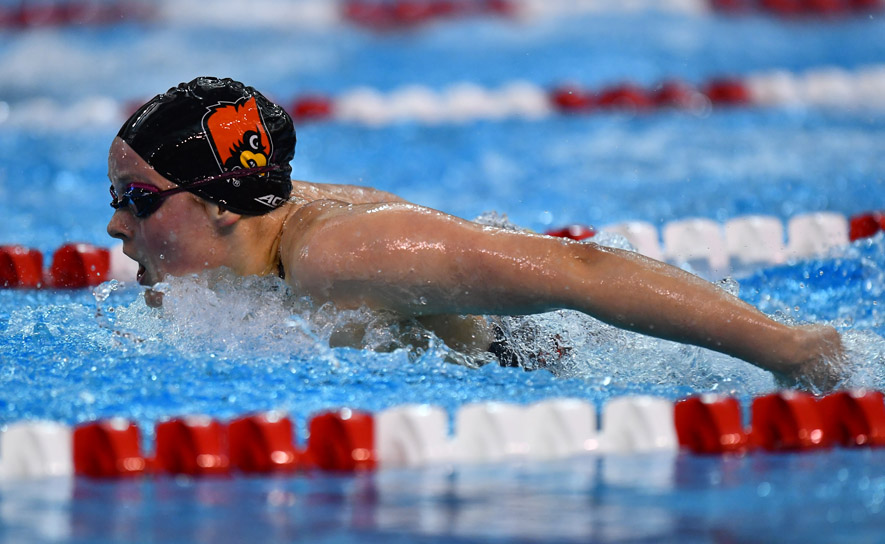USA Swimming News
10 Reasons to Love the 200 Butterfly

by Mike Gustafson//Contributor
Every swim event tells a story: Some tell a story of flash-and-dash. Others tell a story of pacing and strategy.
And, if every story is a love story, as the saying goes, then every length of the 200 butterfly is an epic saga of tragic, painful, and ultimately triumphant adventure. Each length of the 200 butterfly tells a story-within-a-story, with its own beginning, middle, and end. Some stories begin with smooth waters, calm seas, and a successful voyage. Others begin with a naive age grouper sprinting the first 50 yards, then end with coughing, gagging, blacking out, being hauled out of the water by a concerned official (See: Me, Age 14, 200 Long Course Butterfly, YMCA National Championships.)
But there is love within that 200 butterfly story. Its own kind of love. A special kind of love.
For the upcoming Valentine’s Day holiday, I decided to figure out what — if anything — there is to love about the 200 butterfly. I found ten reasons. (There are probably more, but if you find more, you are one of those weirdos who actually enjoy the 200 butterfly.) There they are…
10. Each 200 butterfly is a chess match.
“How can I swim fast, but also survive?” The opposing player is the 200 butterfly. You move and take it out long and strong, and the 200 fly counter-moves with a leg cramp. You decide to negative split the race, and the 200 butterfly sends a rogue wave straight into your throat. Chess is fun. Right?
9. Chasing down competitors in the 200 fly is glorious.
No other event offers the immense gratification of chasing down competitors during final length of the 200 fly. When — out of the corner of your goggles — you see a competitor’s pace slowing down, and you speed up, you feel superhuman. You go for them. You overtake. And it’s glorious.
8. There is fun in the pre-race strategy.
The 200 fly ain’t no 50 free: You can’t fly and die, you can’t sprint ‘til you hit a wall. There are calculations. There is a strategy. And this strategy is as multi-faceted and varied as an episode of Game of Thrones. In other words: Understanding how to race the 200 fly is part of the fun.
7. The 200 butterfly competition field isn’t as crowded as, say, the 100 free.
Let’s face it: The 200 butterfly isn’t the most popular of events. That said, there’s more opportunity to rise through the ranks. Fewer heats means fewer competitors, which means more chances for a championship final appearance.
6. Endeavored infrequently, 200 butterfly time drops are plentiful.
When I was an age group swimmer, I swam the 200 butterfly once a season. And when you only swim an event once a season, you’ll have big old-fashioned age group time drops. Gotta love those big chunks of time erased from personal bests.
5. No one questions the toughness of a 200 butterflyer.
“What event do you swim?”
“200 fly.”
[Bows before you.]
4. It’s easier than the mile.
Debatable, but probably true.
3. Finishing any 200 fly is a badge of honor.
Finishing the 200 fly is one of the best feelings in swimming. You feel confident (tired), elated (tired), and proud (also tired). But finishing that event is in itself a badge of honor.
2. It’s not that bad.
I joke around on this website a lot about the 200 butterfly. But it’s really not that bad. The more you do it, the more fun you have with it. With a nice strategy and race plan, the 200 fly is actually (!) enjoyable. If you’re an age grouper nervous about an upcoming 200 fly, don’t be. Just realize that you can’t sprint the first 50. (Don’t.) That’s it.
1. Pool cred.
If you want instant “pool cred,” become a 200 butterflyer. Tough, resilient, determined, passionate. 200 flyers are “swimmers’ swimmers,” meaning they embody the true definition of what it takes to be a swimmer.
And if that’s not enough to love the 200 butterfly, sign up and swim it, and see for yourself.
(Just don’t sprint the first 50.)
